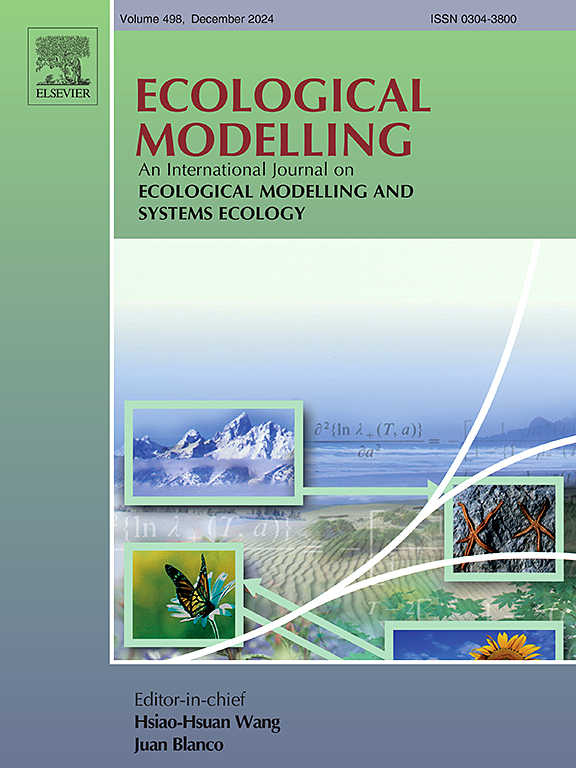Advantages and disadvantages of using social information for carcass detection–A case study using white-backed vultures
IF 2.6
3区 环境科学与生态学
Q2 ECOLOGY
引用次数: 0
Abstract
Utilizing social information during foraging, wherein individuals observe how others interact with their environment rather than relying solely on individually acquired information, is a widely used strategy across the animal kingdom. Nevertheless, our understanding of how different environments shape the extent of social information use remains limited. Here, we assessed the advantages and disadvantages of contrasting foraging strategies in different environments in terms of vulture and carcass density, at the individual, population and ecosystem level. We built an agent-based model to simulate three foraging strategies of African white-backed vultures in Namibia: nonsocial, local enhancement, and chains of vultures. This model incorporated field-derived parameters including vulture and carcass density, and flight characteristics of foraging vultures. From the model outputs, we calculated searching efficiency, competition for resources, and scavenging efficiency and compared the results with observed field data. The results highlight social foraging strategies as overall more advantageous than the nonsocial strategy. The chains of vultures strategy outperformed local enhancement only in terms of searching efficiency under high vulture densities. Furthermore, our findings suggest that vultures in our study area likely adopt diverse foraging strategies influenced by variations in vulture and carcass density. The model developed in this study is potentially applicable beyond the specific study site, rendering it a versatile tool for investigating diverse species and environments. Exploring the role of social foraging holds significant implications for the long-term sustainability of populations and ecosystem processes.
利用社会信息探测尸体的利弊--以白背飞燕为案例的研究
在觅食过程中利用社会信息,即个体观察他人如何与环境互动,而不是完全依赖个体获取的信息,是动物界广泛使用的一种策略。然而,我们对不同环境如何影响社会信息使用程度的了解仍然有限。在这里,我们从个体、种群和生态系统层面评估了不同环境中秃鹫和秃鹫尸体密度的觅食策略的利弊对比。我们建立了一个基于代理的模型来模拟纳米比亚非洲白背秃鹫的三种觅食策略:非社会性策略、本地增强策略和秃鹫链策略。该模型结合了实地参数,包括秃鹫和尸体密度以及秃鹫觅食时的飞行特征。根据模型输出结果,我们计算了搜寻效率、资源竞争和清扫效率,并将结果与观察到的野外数据进行了比较。结果表明,社会觅食策略总体上比非社会觅食策略更有利。在秃鹫密度较高的情况下,秃鹫链策略仅在搜索效率方面优于局部增强策略。此外,我们的研究结果表明,在我们的研究区域,秃鹫可能会受到秃鹫和秃鹫尸体密度变化的影响而采取不同的觅食策略。本研究建立的模型有可能超越特定的研究地点,成为研究不同物种和环境的通用工具。探索社会觅食的作用对种群和生态系统过程的长期可持续性具有重要意义。
本文章由计算机程序翻译,如有差异,请以英文原文为准。
求助全文
约1分钟内获得全文
求助全文
来源期刊

Ecological Modelling
环境科学-生态学
CiteScore
5.60
自引率
6.50%
发文量
259
审稿时长
69 days
期刊介绍:
The journal is concerned with the use of mathematical models and systems analysis for the description of ecological processes and for the sustainable management of resources. Human activity and well-being are dependent on and integrated with the functioning of ecosystems and the services they provide. We aim to understand these basic ecosystem functions using mathematical and conceptual modelling, systems analysis, thermodynamics, computer simulations, and ecological theory. This leads to a preference for process-based models embedded in theory with explicit causative agents as opposed to strictly statistical or correlative descriptions. These modelling methods can be applied to a wide spectrum of issues ranging from basic ecology to human ecology to socio-ecological systems. The journal welcomes research articles, short communications, review articles, letters to the editor, book reviews, and other communications. The journal also supports the activities of the [International Society of Ecological Modelling (ISEM)](http://www.isemna.org/).
 求助内容:
求助内容: 应助结果提醒方式:
应助结果提醒方式:


